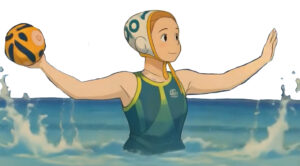Throwing a ball is mastered early on for most kids. Being able to stand up in a shallow pool is also an easier thing to do. Kids often need games that have structure to them to keep themselves staying longer in the pool rather than descending into chasing games or talking too loudly or being unable to make decisions about what to do. Balls that float are easy to find in stores. Small balls are easier to pick up but they can be harder to catch especially if you are needing to float at the same time by moving your legs around.
Some countries play primary school water polo in a normal 25 m swimming pool where the kids stand up rather than swim. They still throw the ball to each other in a team but don’t need to focus on swimming or not drowning or keeping up with everyone. Waterpolo is an aggressive sport. It is hard to see underwater where the other person is so you might get kicked or pushed or hit as you swim around another person. It’s not that they are trying to hurt you but they just can’t see well because of the water and how fast everyone is moving. Waterpolo is an exhausting game.

Skills for water polo:
Being able to swim laps easily
Being able to throw a ball one handed over a long distance
Being able to catch a large ball in one hand and not let it drop into the water
Tolerating being splashed in the face with lots of water
Ability to change directions between swimming forwards and swimming backwards very quickly
Physical endurance
Ability to protect yourself from a ball coming at you by using your arms to wave it away or block it away and to use your legs to swim at the same time
Ability to swim without goggles
Learning how to swim close to someone but not on top of them or touching them as you both swim towards the same ball at the same time at your fastest speed
Being able to predict the balls path as another player throws it past you and waving a hand in front of it to stop it or catch it.
Taking turns passing the ball to others
Identifying openings in the rectangular goal that is not protected by the positioning of the other teams players and goalie
Learning how to swim faster than other people over short distances, over medium distances
Having patience to help protect your team mates from stronger players
Knowing your strengths and areas to improve
Activities for home pools:
Lightweight balls bounce off of your hand and are much harder to throw and catch in the waterpolo required one hand only. Waterpolo balls themselves are large. They require a full open hand with fingers spread out completely. Accuracy for throwing is helpful in any sport. Using tennis balls or any toddler ball is ok. It won’t be enough though because of the size of the pool in a waterpolo match. Most home pools are too small and they don’t have enough deep ends or shallow ends to practice in. Having a parent stand out of the pool and throw a ball back and forth one at a time is helpful for practicing the balance of keeping swimming and not going under the water too much and catching and throwing the ball at the same time.
